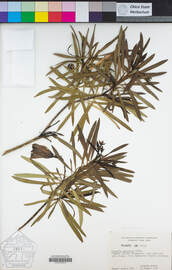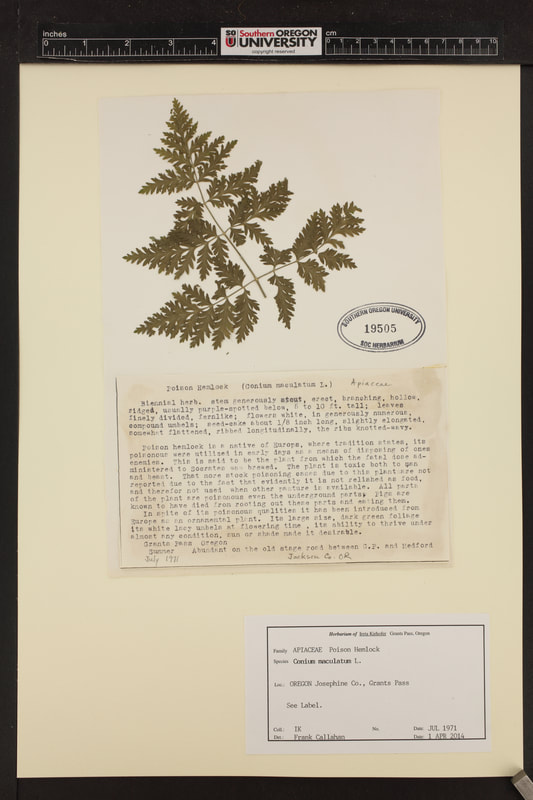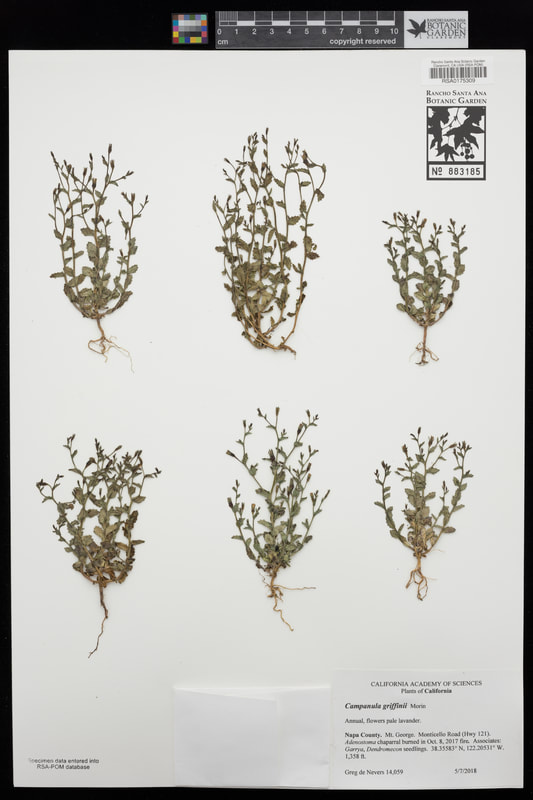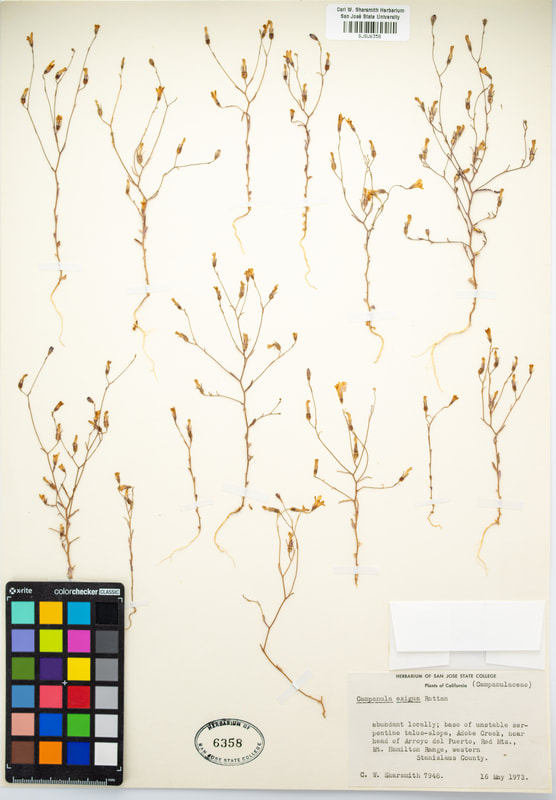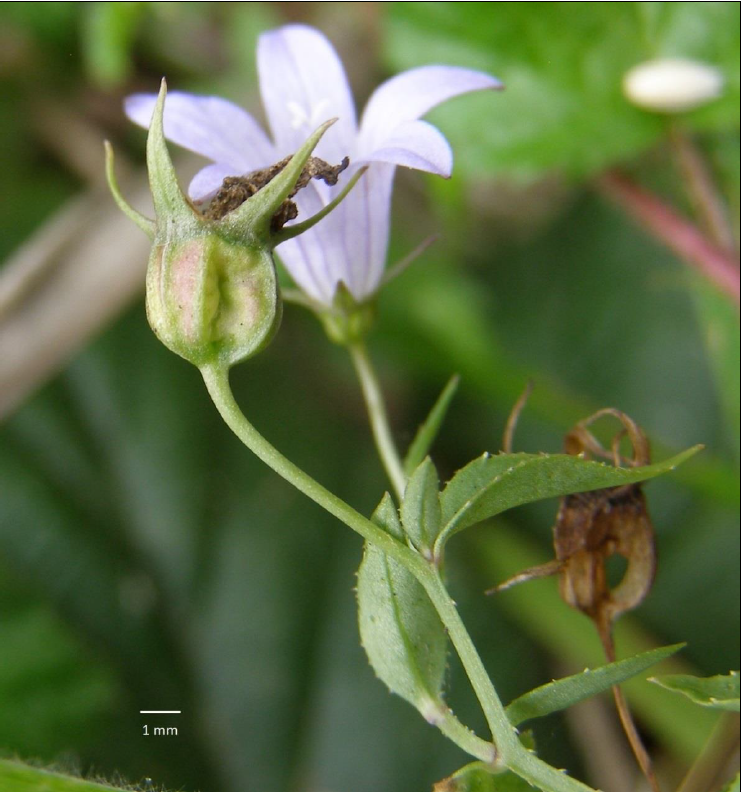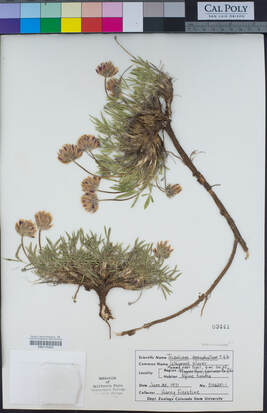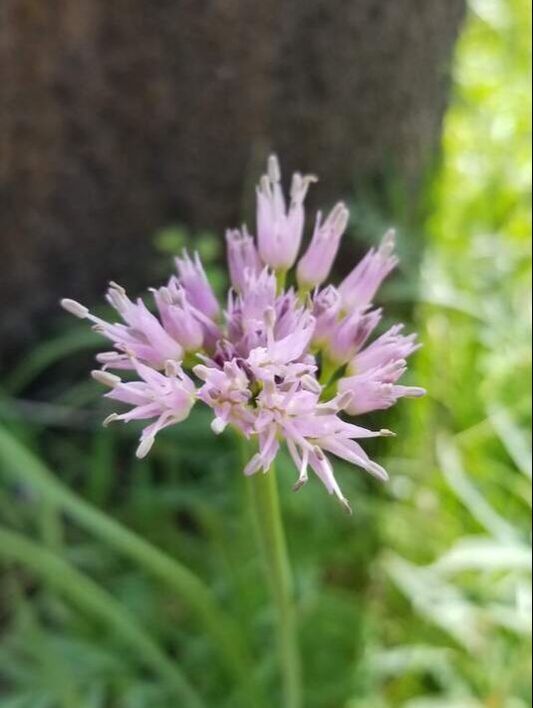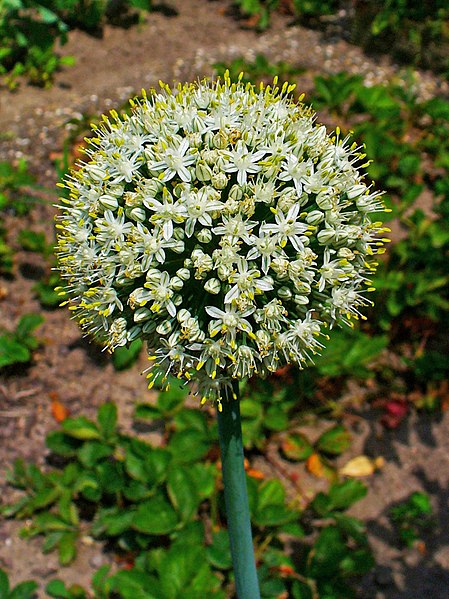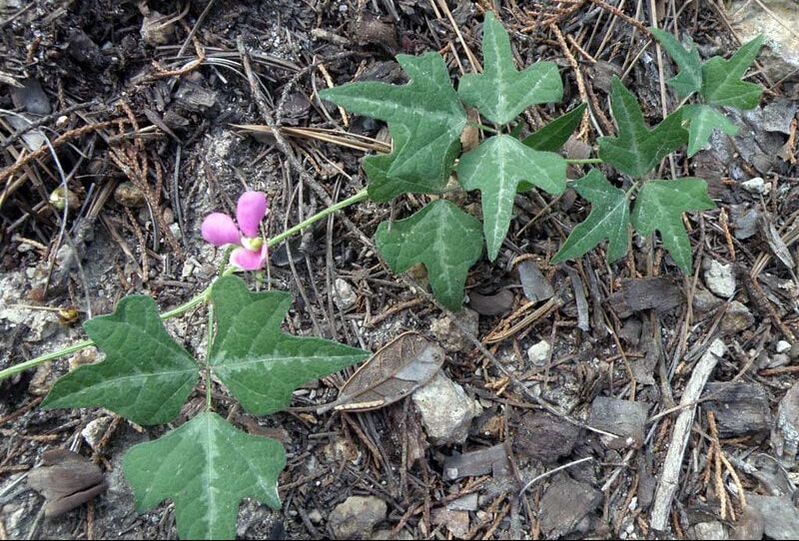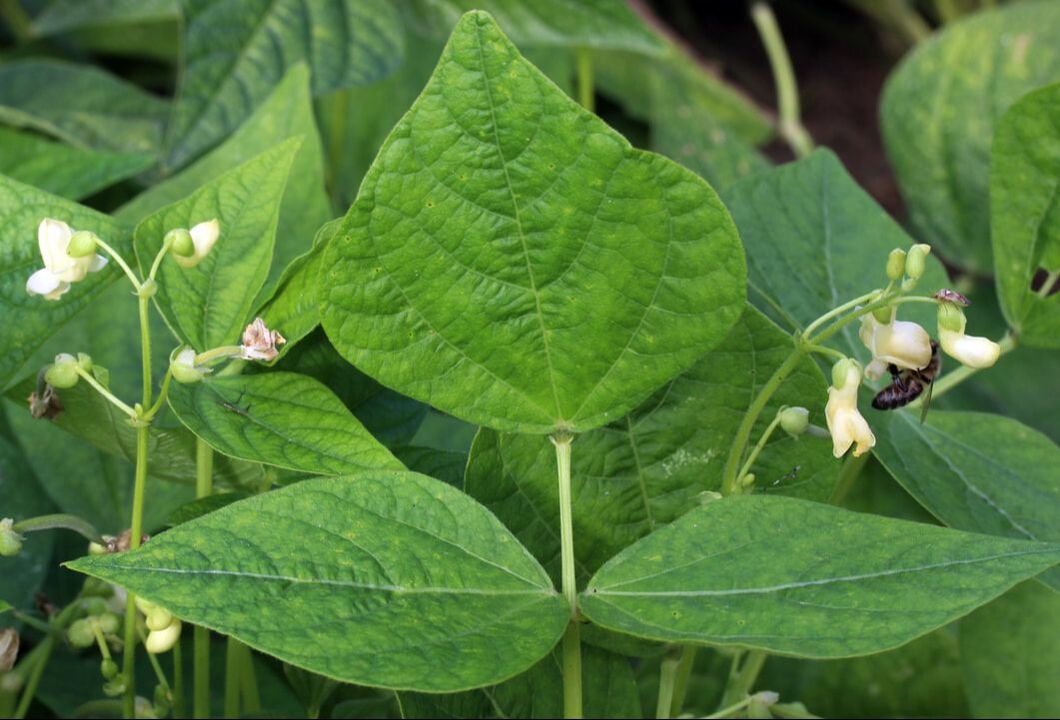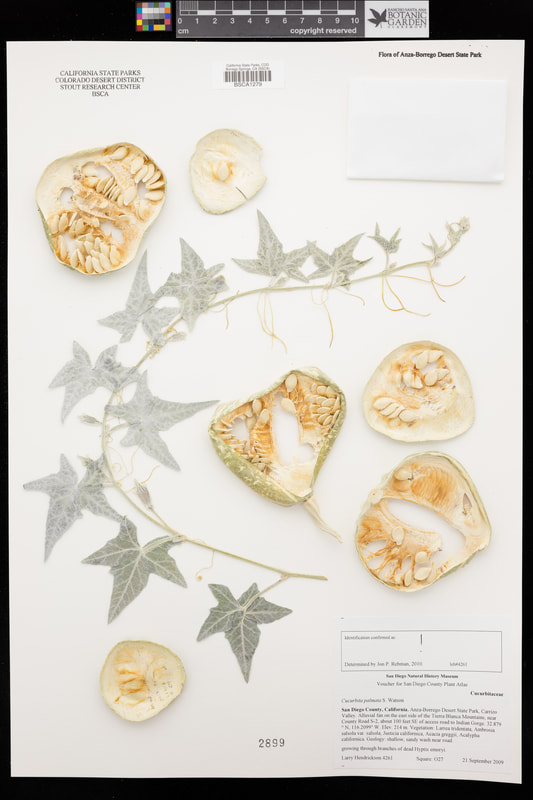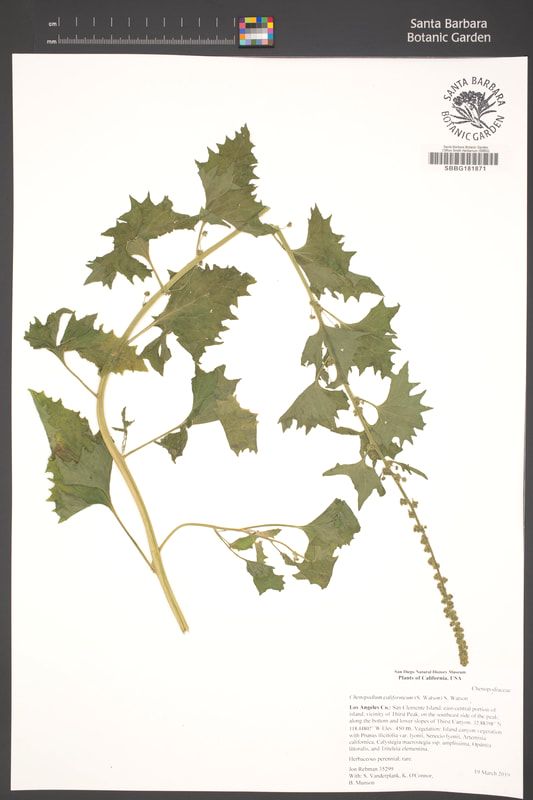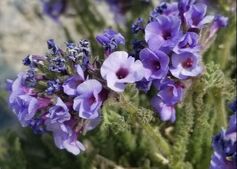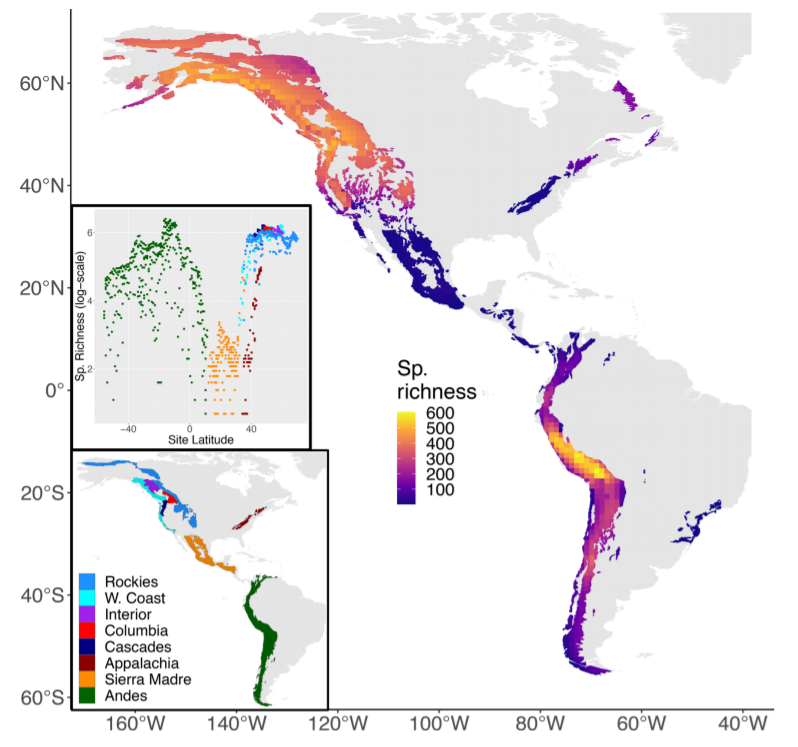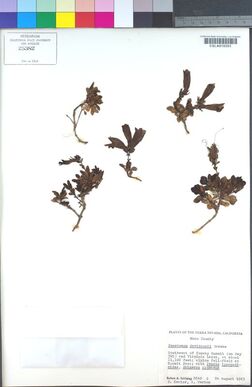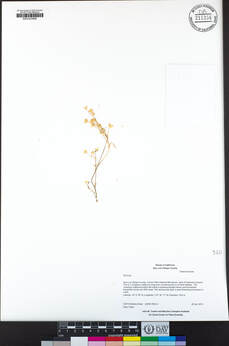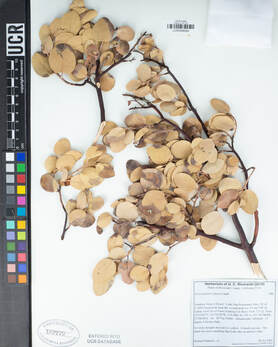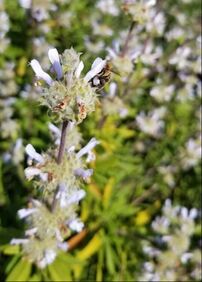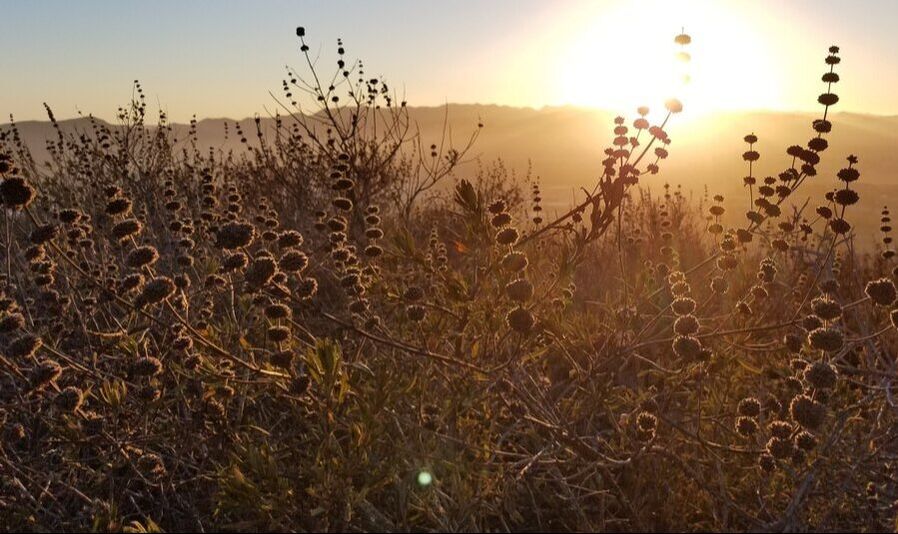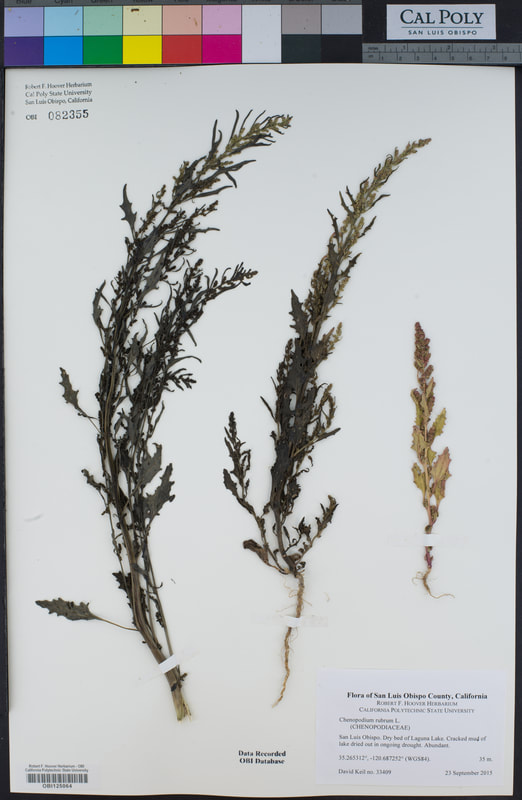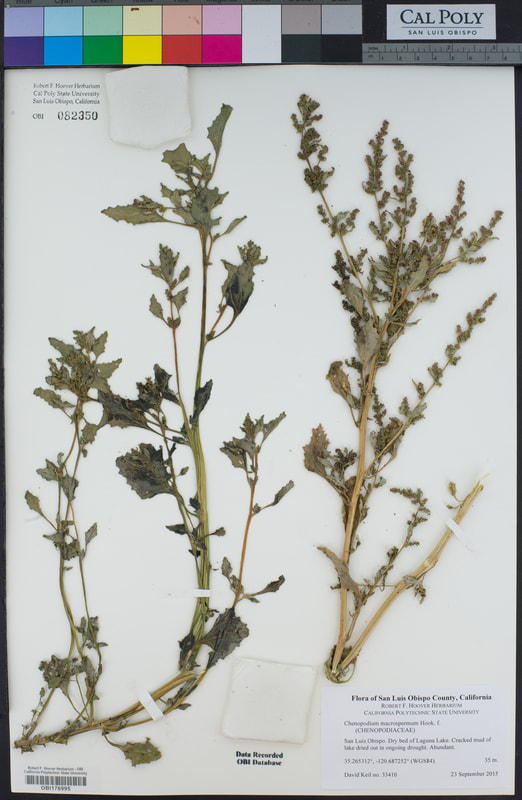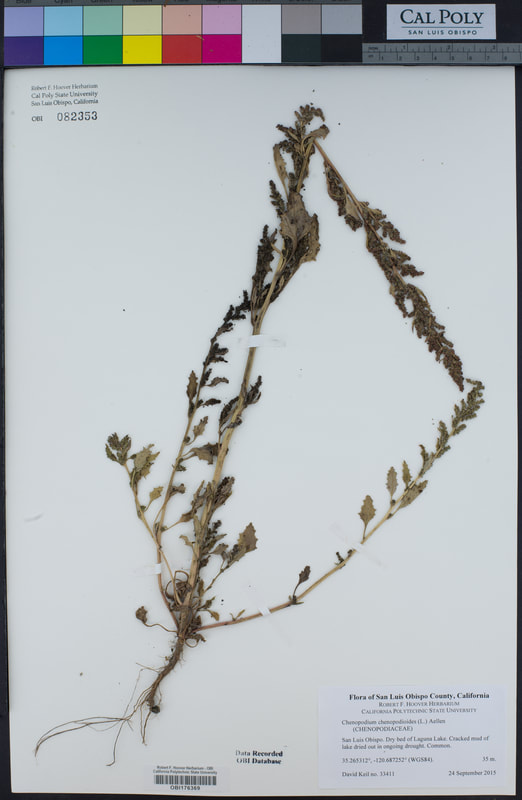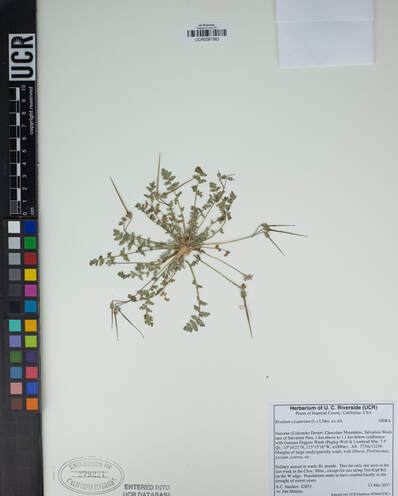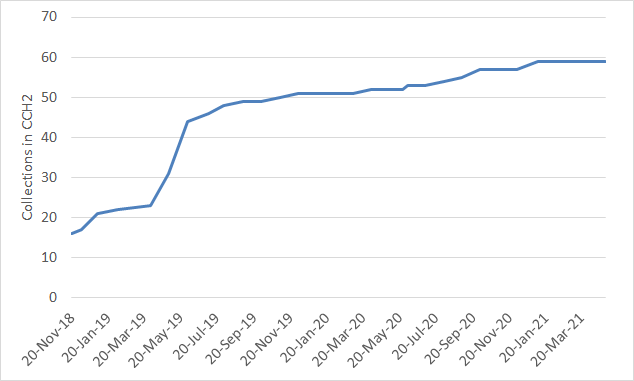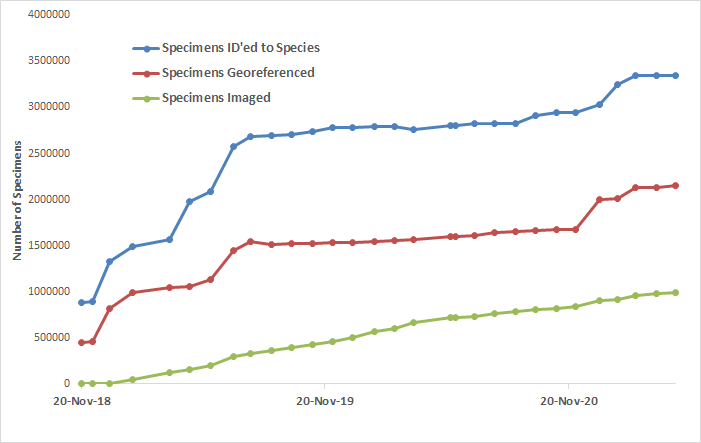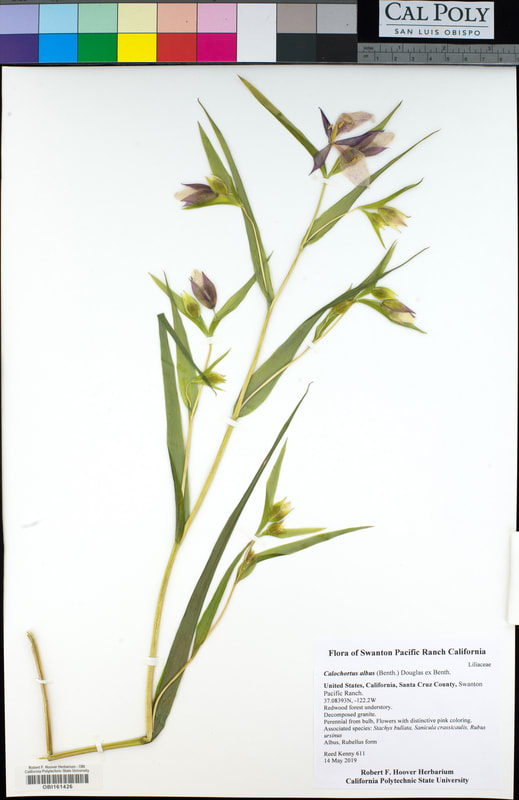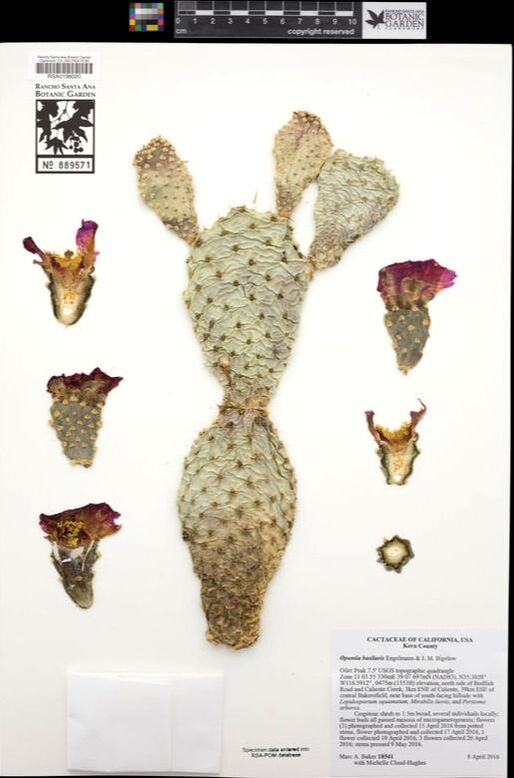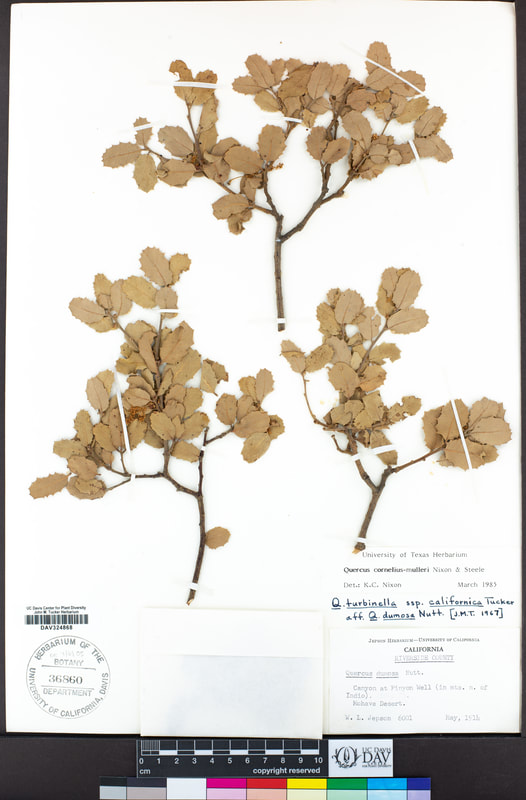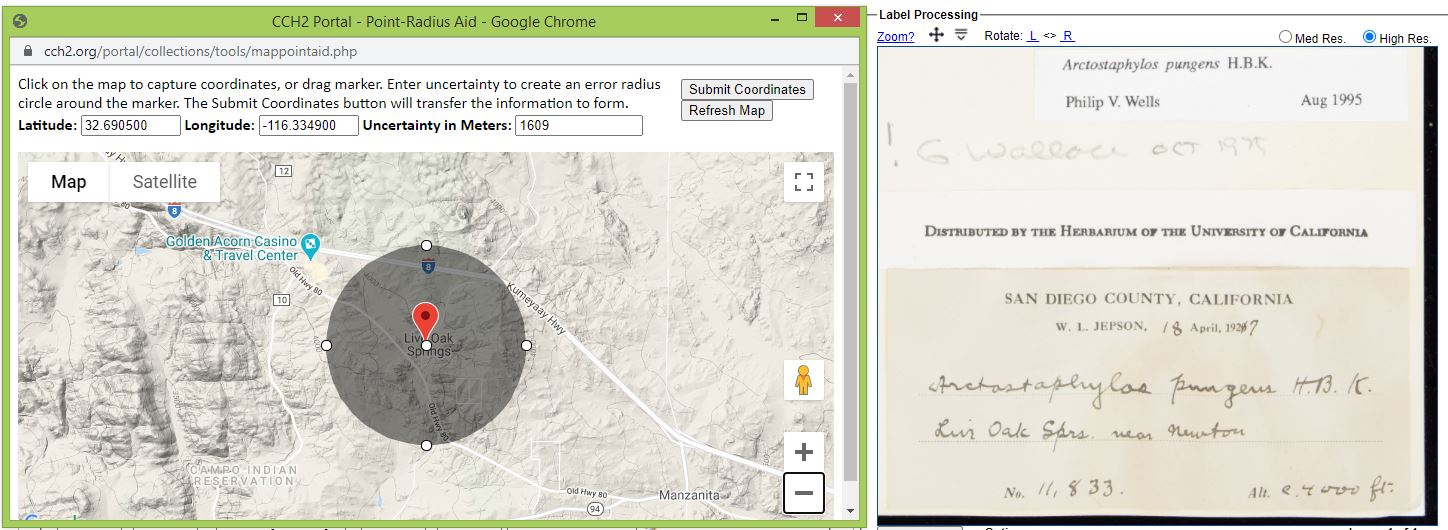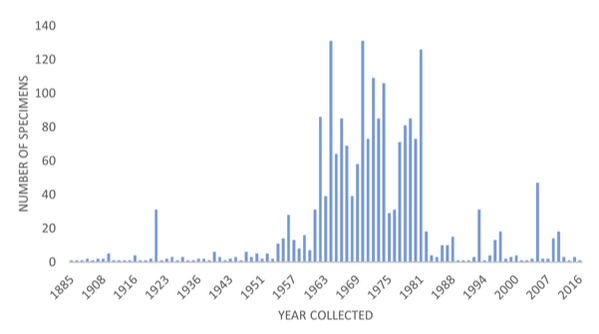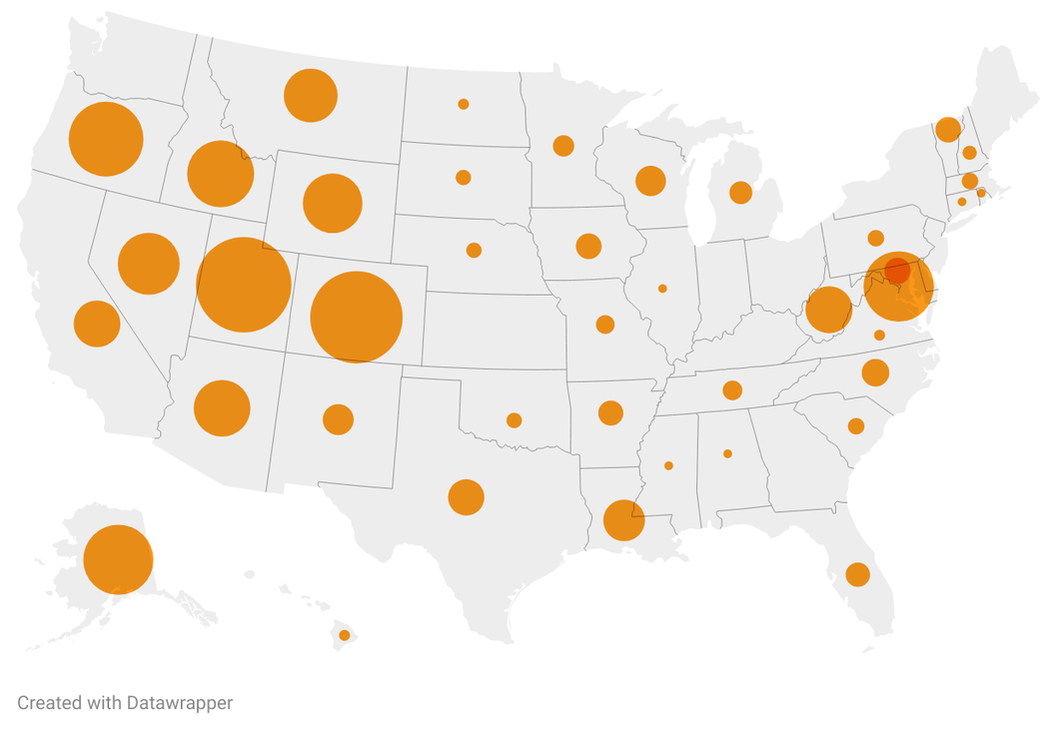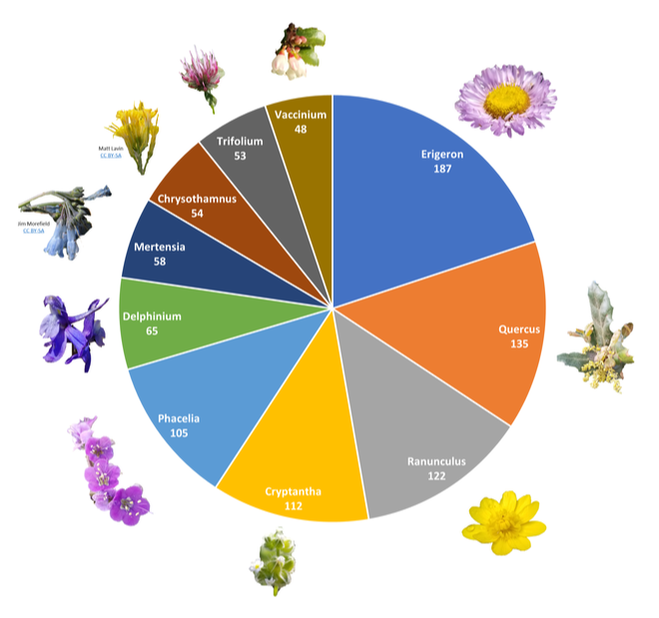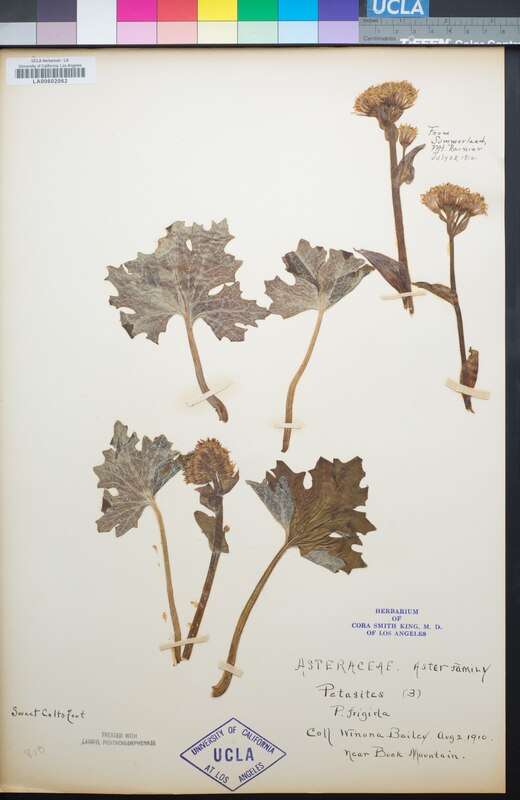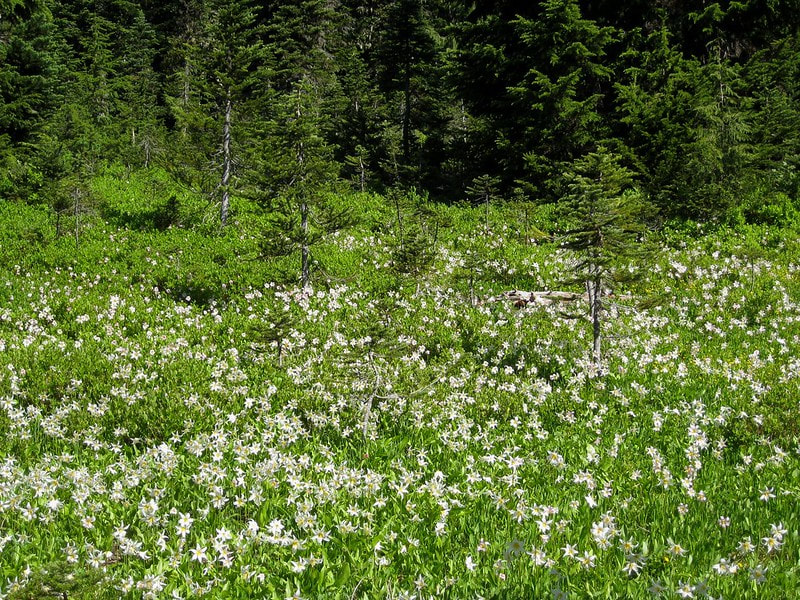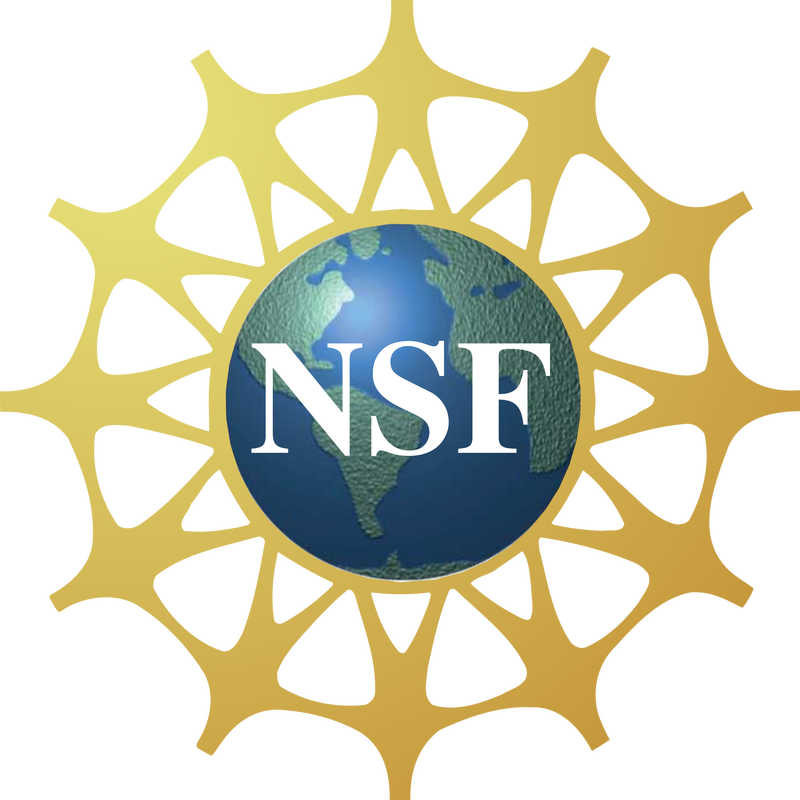| One thing that I’m getting concerned about is animal poisonings from oleander relatives (Apocynaceae). This has been goats so far, as owners tend to clip their shrubbery and feed it to their pet goats. Goats can eat a lot of things and do OK but they cannot survive ingesting the compounds in oleander and its relatives. Most Californians are aware of the toxic properties of oleander (Nerium oleander), but there are tropical relatives that are getting popular in horticulture, especially southern California, where it doesn’t freeze. Among these are yellow oleander (Cascabela thevetia/Thevetia peruviana). I’ve seen this deadly plant for sale at garden centers with no warning on it at all! |
|
As catalogs of physical plant specimens, herbaria are fantastic resources for identifying unknown plants, and this utility isn't just for scientific studies or simple curiosity. Sometimes plant identification is a matter of life or death. Some herbaria receive samples from herders, farmers, or citizens concerned with the potential poisoning of livestock or pets. Because many plants can be poisonous, identification of unknown plants in grazing areas or farmland can be an important preventative (or investigative) measure to prevent the loss of life. Dr. Alison Colwell, curator of the UC Davis Herbarium, and her team, are frequently called upon to identify plants suspected of animal poisoning. She explains: "Because UC Davis has a veterinary medical school with a diagnostics program, the herbarium gets referrals when animals are thought to be poisoned by plants, this can happen several times a week, mostly in the summer. There are certain plants that recurrently cause grazing animal poisoning, notably Amsinckia and Plagiobothrys in the spring, and Lupinus seeds in early summer, so I’m starting to know the Who’s Who of poisonous plants in California. Ideally, the owner of the affected animals will go around and pick the remainder of the nibbled plants and send them in. Sometimes we get a big bouquet of everything in the pen/corral/field. Often they will just send photos and if those are in focus and include diagnostic features, we can often do an ID from the photo, but we prefer fresh material to confirm ID against our herbarium specimens under the scope, as we have a very good collection of weedy and toxic species here. Sometimes we get part of a bale of hay and have to pick through it to find the weeds, we keep large plastic pans for that messy procedure. The most challenging ID is the contents of the gut of dead livestock, which is both fragrant and fragmentary. The toxicology folks kindly rinse off the plant parts before sending the sample over, but it will still smell a bit. I’ve come to recognize the odor of the contents of a rumen. This part of my job is causing me to see landscaping in a different way – these days when I’m walking down a city street, I’m starting to see the plants in terms of their toxicity instead of their attractiveness! Herbarium staff and other botanists use their knowledge, reference texts, and physical herbarium specimens to conduct this identification process. Not only are herbarium specimens a crucial reference for identification, but they are also used to document the establishment, distribution, and spread of potentially poisonous plants across history. Take for example, the specimen below. On the (especially detailed) note, the collector of this plant chronicled the saga of poison hemlock. He notes, "The plant is toxic both to men and beast...." and "...In spite of its poisonous qualities it has been introduced from Europe as an ornamental plant." Poison hemlock is now widespread across the United States (just look at the distribution of this species across California in this map!). Knowing where it came from, the habitats it inhabits, and its potential pattern of spread may help us prevent it from spreading further and help us seek out where it may have quietly become established. There's no replacement for a robust herbarium record of plants, native and introduced. By the way, did you notice that this specimen hails from the Southern Oregon University? Political boundaries weren't drawn with natural biomes in mind, and a large chunk of the the California Floristic Province is found in southwestern Oregon. To ensure the best possible coverage of the CFP, our friends at the Southern Oregon University Herbarium are now serving a copy of their data in CCH2. This has brought 22,000 new specimens to the CCH2, along with 20,000 images like the one shown above. California herbaria aren't the only ones collecting, digitizing, and curating these resources; the herbarium community is broad and more interconnected than ever in our work to catalog, protect, and promote biodiversity.
0 Comments
Morin, N. Taxonomic changes in North American Campanuloideae (Campanulaceae). Phytoneuron (2020). 49:1-46 New species of bellflower in North AmericaIf you think that all plant species have already been discovered and named, think again. Even in our own backyard, scientists are continuing to uncover evidence that re-shapes our understanding of plant diversity. As a recent example pertinent to our California flora, we have taxonomic work of Dr. Nancy Morin, a researcher with the UC and Jepson Herbaria. While working on the Flora of North America, Morin noticed that one particular group of bellflowers, the genus Campanula, appeared to consist of many species that may not be as closely related as scientists may have once thought. Thus, she embarked on a journey of taxonomic revision, the gathering and re-examination of evidence used to delineate and describe species. Re-defining species is an enormous task, requiring the researcher to gather data of many kinds. To decide the boundaries of the species and characteristics that define then, Dr. Morin had to gather distributional data (where the plant lives), ecological data (the environments in which the plant is found), morphological data (what the plant looks like), historical data (how the plant has previously been named or described), and often, genetic data (the species' DNA). Fortunately, herbarium specimens represent many of these data types, and as more historical records are digitized and imaged, Morin had access to an increasing wealth of botanical data. Dr. Morin downloaded herbarium specimen data from GBIF, viewed specimen images, and spent many hours poring over the physical specimens in and from many herbaria. (In the acknowledgements of her paper, she cited visiting 10 herbaria and receiving loans from 82, eleven of which are members of the CAP Network!) Herbarium specimens of species formerly in the genus Campanula according to Morin's taxonomic treatment, from the California Botanic Garden Herbarium (left), San Jose State University Herbarium (center), and UC Santa Barbara Herbarium (right) Upon reviewing the evidence, Dr. Morin concluded that this North American clade of Campanula should actually be split into eight genera consisting of 12 species. Six of these genera are new to western taxonomy, and Dr. Morin took this opportunity to name several after prominent botanists.
Three of the new genera are named after currently living botanists:
In this way, herbarium specimens and the researchers that use them also represent a unique intersection between science and history: the plants, but also the people who tirelessly explore the natural world and eagerly share their discoveries. Glossary
This week we pause to remember a biologist near and dear to the California community, a dedicated devotee to exploring and explaining the natural world who passed away this April: Dr. Harry Fierstine. Dr. Fierstine was a native of California; he earned his PhD at UCLA and then moved to San Luis Obispo, where he taught biology, zoology, comparative anatomy, and ichthyology (the study of fish) at California Polytechnic State University for 29 years. However, like most natural scientists, Dr. Fierstine's curiosity was much broader, and his publications profess an interest across the globe. He studied fossils of marlin from California to Virginia, South Carolina to the Philippines. In one, almost comical study, Dr. Fierstine examined the rostra (beak-like "noses") of supposed swordfish that had been found embedded in the hulls of wooden ships from the early 19th century (Fierstine & Crimmin, 1996). By measuring the rostra and studying their shape, he and a colleague determined that the rostra belonged not to swordfish (Xiphias gladius), but marlins (Makaira spp.). Prior to this study, few scientists had recognized this "spearing" behavior in marlins. Dr. Fierstine contributed much to our understanding of these enormous, mysterious fish.
Works cited
Khoury, C.K., Carver, D., Greene, S.L., et al. Crop wild relatives of the United States require urgent conservation action. Proceedings of the National Academy of Sciences of the United States of America (2020). https://doi.org/10.1073/pnas.2007029117 Crop wild relatives of the United States require urgent conservation actionOur next story of digitized herbarium specimen data fueling novel research stems from a collaboration of nine scientists at the US Department of Agriculture, International Center for Tropical Agriculture in Colombia, Museo de Historia Natural Universidad Nacional Mayor de San Marcos in Peru, Smithsonian Museum of Natural History, and NatureServe. These researchers sought to quantify just how threatened crop wild relatives—that is, non-domesticated species that are close relatives of domesticated crops—may be in the United States. Crop wild relatives are an important focus of agricultural and conservation research because these species may hold genetic information that could add diversity to our current domesticated crops. Lack of genetic diversity (think number of unique genes and gene combinations) can make species susceptible to disease and detrimental mutations. With fewer "tools" in their genetic toolbox, species with low genetic diversity may not be able to adapt to changes in their environment, such as changes in the timing and quantity of precipitation, heat, and pollinator availability. By conserving and potentially cross-breeding crop wild relative species with crop species, we may be able to produce a more genetically robust and sustainable food source for the growing human population.
Using occurrence data (including herbarium specimen records) and data from gene banks, Khoury et al. conducted conservation assessments for 594 crop wild relative plants that are native to the U.S. They used these 276,312 records to quantify how vulnerable the species may be based on how many records exist and how much land the taxa currently occupy. What they found was concerning: 42 taxa may be critically endangered in their natural habitats, 297 may be endangered, and 166 may be vulnerable. Only 3.9% of taxa that they studied were in little danger of losing critical levels of genetic diversity or going extinct. Khoury et al. also found that 14% of the study taxa are not currently preserved at seed banks or botanical gardens. This could mean that, if these taxa go extinct, we will have little to no ability to utilize their genetic diversity for existing crops. 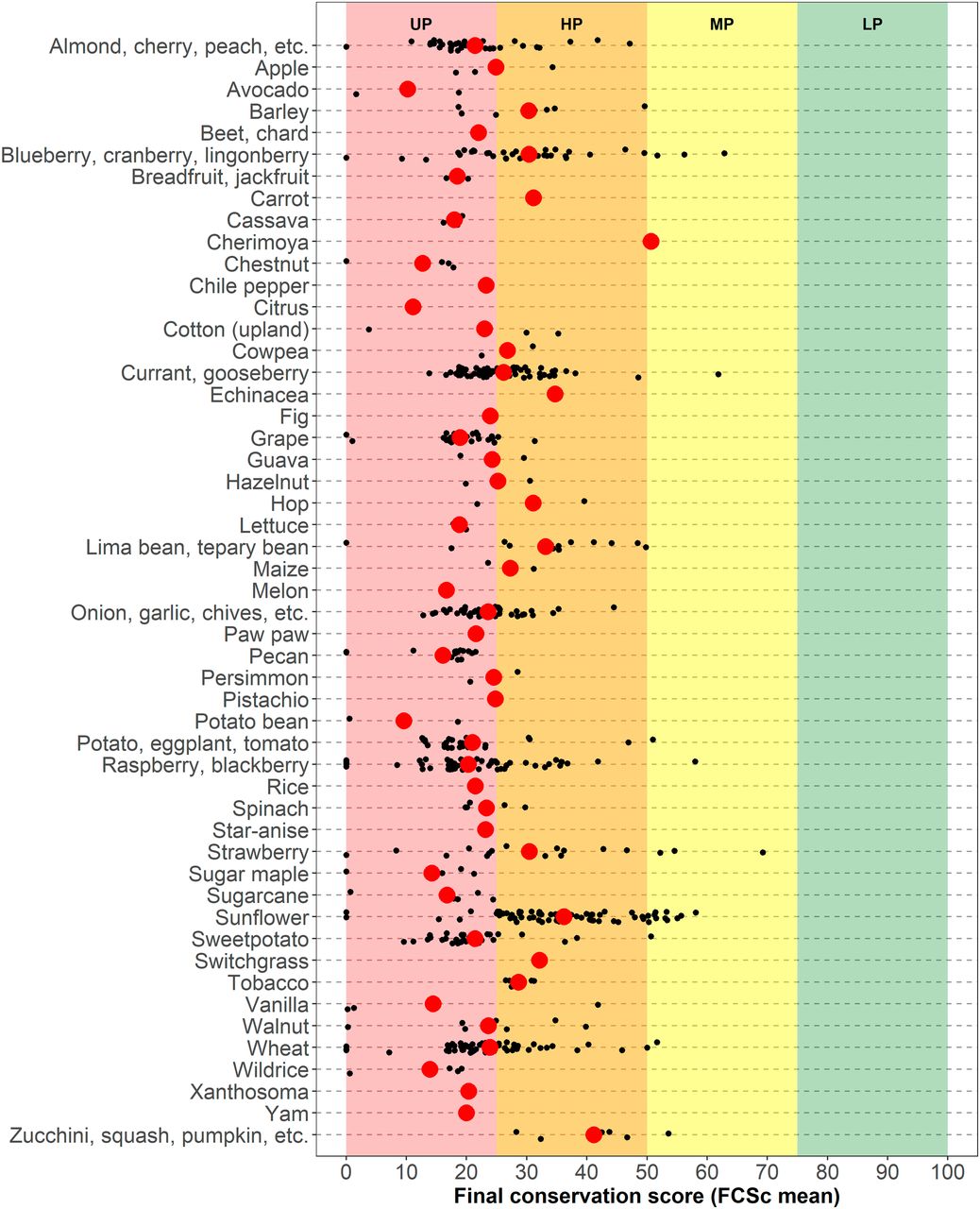 Fig. 4 from Khoury et al. 2020 (reproduced with permission from Colin Khoury). Final conservation scores (FCSc-mean) for US native crop wild relatives (black circles), grouped by associated crop/wild food plant, with the average score across taxa (red circles). FCSc-mean is used to categorize taxa for further action as UP (Urgent Protection), HP (High Protection), MP (Medium Protection), or LP (Low Protection). [Figure caption modified] Data from many California herbaria were included in these analyses, providing the baseline knowledge of where these plants have occurred historically and lending insight into where they may currently exist. Thanks to research like that described in this paper, empowered by specimen data, we can identify which species we are most in danger of losing. Such research is critical to directing future conservation efforts and public policy.
You can do a lot of science with 3 million herbarium specimen records. By making our digitized specimen data available not only through the CCH2 portal, but also through global aggregators GBIF and iDigBio, researchers across the world can view and use this valuable resource for studies in their fields. Research topics vary from species endemism and distributions, to invasive species, to human health and fire ecology. In this and upcoming blog posts, we will highlight recently-published papers from research communities outside of California that nevertheless use data from California herbarium specimens to explore and explain our natural world in new and exciting ways. Patterns of diversity of American alpine speciesFigueroa, H.F., Marx, H.E., de Souza Cortez, M.B. et al. Contrasting patterns of phylogenetic diversity and alpine specialization across the alpine flora of the American mountain range system. Alp Botany (2021). https://doi.org/10.1007/s00035-021-00261-y
Alpine ecosystems are characterized by inhospitable abiotic conditions; bitter cold, high UV exposure, harsh winds, and rocky, eroding soil are just a few factors that plant species in these areas have faced over evolutionary time. Despite this, thousands of species (2,937 of which are included in this paper) have evolved to live in these environments, and Figueroa et al. wanted to understand how they came to be. Figueroa et al. used species distribution models to compare patterns of diversity due to phylogenetic (i.e., evolutionary relatedness) and abiotic factors. They found that different alpine communities across the Americas—for example, Patagonian versus Rocky Mountain communities--showed different patterns of diversity, suggesting that each region assembled due to unique factors. In other words, harsh climatic conditions alone don't necessarily determine which species can exist in an area, yet assembly does not depend solely on species being at the right place at the right time (the history-filtering hypothesis). They also found that species richness did not follow a simple latitudinal gradient (species in other environments and taxonomic groups have been shown to display a latitudinal gradient in species richness, with highest diversity around the equator). This work represents an important use of millions of herbarium specimen records to answer a foundational question in evolutionary biology; and many hundreds of thousands (over 600,000, to be more precise) of these specimens originated from our very own California herbaria! The dataset included specimens from the San Diego Natural History Museum Herbarium, UC Riverside Herbarium, CSU Chico Herbarium, Robert F. Hoover Herbarium at Cal Poly State University, and several others. California herbaria play an important role in shaping our understanding of global evolutionary patterns.
Glossary
Drought: it's a reality for the warm, Mediterranean climatic region of California, especially as human land use changes the landscape and greenhouse grasses trap heat. Drought can affect plants in many ways. On a physiological level, lack of water produces stress, which can inhibit plant growth and reproduction. Some plants change in appearance or stature under drought stress, often remaining small in size or limiting fruit set, like what might have happened to the Gilia on the left below. Some plants' foliage may wilt, shrivel, and/or die back, like the discoloring manzanita on the right. In the face of annual "droughts" during the summer months, many species in California have evolved to be "drought deciduous", meaning they die back in the summer and resume growth and reproduction after winter and spring rains. The iconic species black sage (Salvia mellifera) and California sagebrush (Artemisia californica), for example, are drought deciduous and will often turn brown and lose their leaves in the hot summer months. Still, these plants can be negatively affected by long-term droughts. Too many drought years in a row can kill individuals of even these hardy, well-adapted species. Drought can also alter plant communities, for example, by allowing drought-tolerant, often "weedy" species to take advantage of the open real estate and weakened competition. The specimens below serve as striking examples; as Laguna Lake in San Luis Obispo shrunk into a cracked, dry bed during the 2012-2016 California drought, three different species of opportunistic goosefoot (Chenopodium) sprung up abundantly in its absence. Other species can temporarily (or permanently) disappear in the face of ongoing drought, as one astute collector noted in some of her collections. She discovered populations of the native annual "clustered tarweed" (Hemizonia/Deinandra fasciculata) the year after the severe drought of 2002, even though the species was "not seen at all in 2002 during severe drought year" (check out the specimen here!).
Herbarium specimens document botanical changes and can help us understand the changing distributions of plants as environmental factors shift, as demonstrated by the examples above. We're so lucky to have such a dedicated community of collectors and botanists who are creating and caring for this resource.
With the end of each academic year, we in the CAP Network often find ourselves reflecting: what have we accomplished? How have we grown? We are happy to share this reflection with you, the community that has supported us and helped us get things done. There is yet much to do, but look how far we've come! The CCH2 portal has grown from fewer than 20 collections to a massive network of 59!These collections come in many shapes and sizes, from the small, localized Sagehen Creek Field Station (just over 1,800 specimens) to the massive holdings of the Jepson and University Herbaria at UC Berkeley (over 560,000 digitized vascular plant records to date). Thirty-three CCH2 collections (56%) contain fewer than 10,000 digitized specimens, and eight (14%) consist of fewer than 1,000! Although smaller in size, these herbaria are vital sources of often unique, specialized collections that document specific regions or the activities of lesser-known collectors. They fill critical gaps in our understanding of these special places (Monfils et al. 2020), yet are often in greater peril of shutting down due to lack of funding or attention. The infrastructure and community bolstered by the CAP Network and the Consortium of California Herbaria may help these smaller collections gain the recognition and help they deserve. CCH2 has grown to include digital data for over 3 million specimens.Perhaps the most obvious metric of CCH success is the sheer number of herbarium specimens now digitized and available in our data portal. Many herbarium collections were never previously digitized or had never made their data public, resulting in data silos and massive unrealized potential. Now researchers and the public have access to 3.1 million herbarium specimen records of over 82,000 species across the world, and these numbers continue to grow each day. 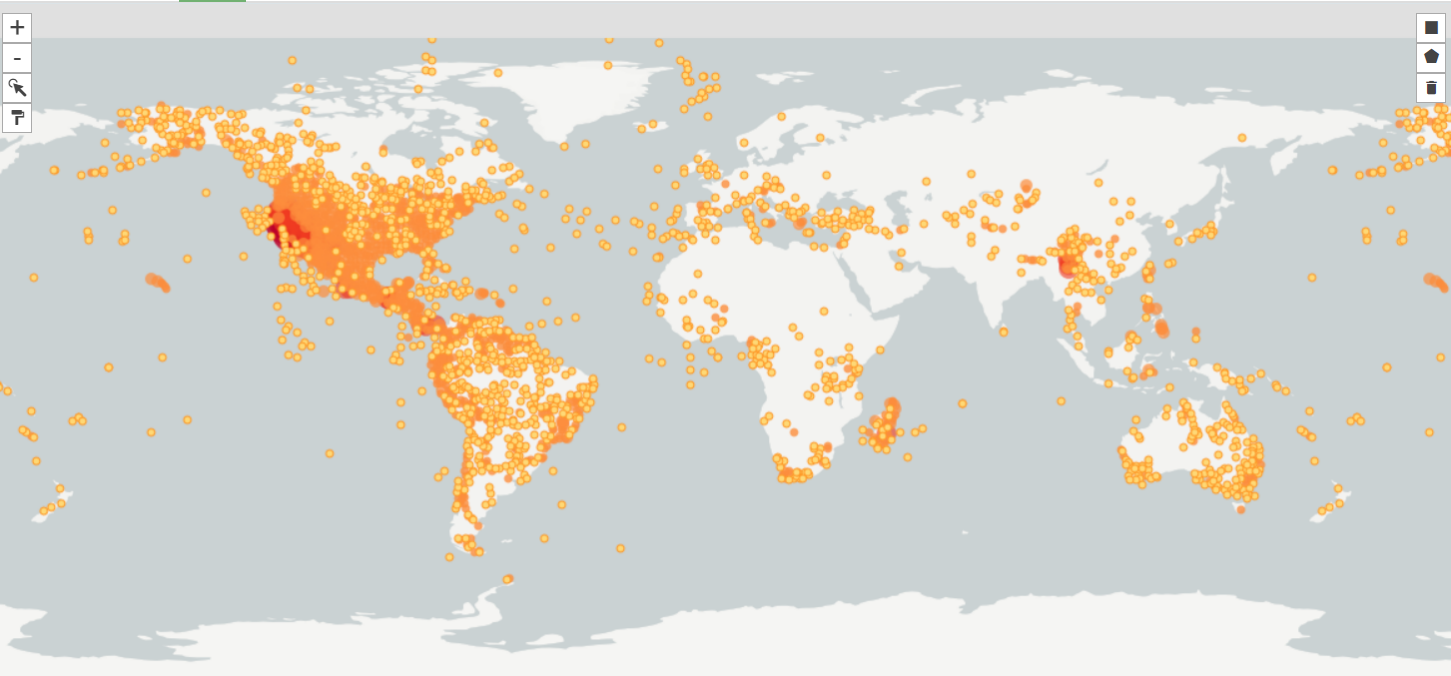 Distribution of CCH specimens in GBIF We started at zero, but now we're up to nearly 1 million images!Imaging specimens has been one of the most urgent goals of the CAP Network. With funding from this NSF grant, we purchased and assembled 17 imaging stations across the state. Not only can these critical tools be used to digitize the historic holdings of collections, but herbaria can now fold digitization into their accessioning pipelines, meaning that present and future specimen data will enter the public sphere more rapidly after collection. Indeed, we currently have over 550 records from 2021! Images of physical specimens have the potential to unlock new discoveries as researchers can now view specimens across institutions side-by-side and measure individual specimens' traits. Broader communities across California and all over the world can now use specimen images to learn how to identify plants, where plants occur, and differences among plant populations. Specimen images are a huge and compelling resource for science and society, connecting us to the living things we find in our daily lives. We're excited for another year of advancing and enhancing this resource...and hopefully long into the future! References
Botanists and naturalists across the state are banding together to deepen our knowledge of where California plants have historically occurred. In September 2020, the California Phenology (CAP) Network launched the “100 Club,” a team of experts who are trained to “georeference” herbarium specimen records in CCH2 (cch2.org), a new data portal that serves vascular plant data from California herbaria. Members of the 100 Club have experience with one or more geographical areas, and they use this expertise to translate textual descriptions of specimen locations into latitude and longitude coordinates: dots on a map. The CAP Network aims to georeference 300,000 herbarium specimens by 2022, and they are well on the way to achieving that goal; however, producing accurate georeferences is often challenging. This is where the expertise of local experts comes into play. “Anyone can read a label and put a dot on the map, but in order for that dot to be accurate, you need people who know an area well. There is no re- placement for local knowledge about a place,” says Jenn Yost, professor at California Polytechnic State University and lead PI of the CAP Network. “Many of our labels refer to place names not found on any map, but if it’s your backyard, you’ll know right where it is.” To date, the 100 Club includes 28 active members representing many vocations and locations, from self-taught botanists, to ecological consultants, to professional botanists and taxonomists, each with expertise ranging from Baja California to the Pacific Northwest. Similarly, specimens in CCH2 originate from across the state and even the globe, underscoring the importance of a diversity of experienced georeferencers. Together, the 100 Club has georeferenced over 8,000 specimen records in only a few months, yet the process has been anything but tedious. “For me, georeferencing is a multidimensional experience,” explains Chris Hauser, manager of the Panoche Valley Preserve and avid 100 Club Member. “When I’m georeferencing an herbarium specimen, it’s as if I’m above tree line at 10,000 feet in the mountains with Dean Taylor or walking through a dark coast redwood forest with Jeff Norman. I can almost hear the wind in the trees, smell the vegetation, and feel the soil under my feet.” Georeferencing herbarium specimens can be an adventure into the past as members explore historical collecting locations—parks, forests, mountains, valleys, and preserves—some of which no longer exist in their natural state. Georeferencers also become familiar with historical and recent collectors, their collecting patterns, and their label styles. Each specimen is like a time capsule, embodying the tireless efforts of passionate people and their botanical escapades. The CAP Network invites everyone with some naturalist experience to join the historical exploration by becoming part of the 100 Club. Each member completes the CAP Network’s online georeferencing training course and receives live, virtual training via Zoom. As members begin to work in the CCH2 portal, they are fully supported through additional training and communication. To sign up, fill out the interest form here: tinyurl.com/37c3m5xb. Thanks to the dedicated efforts of this group of naturalists, more herbarium specimens are georeferenced each day, helping us build a more comprehensive understanding of where and when plants have occurred across California and beyond. These data are critical in the face of a changing climate and potential effects of those changes on California’s precious plant diversity. This article was originally published in the Jepson Globe: A Newsletter from the Friends of The Jepson Herbarium. Vol. 31. No. 1, Spring 2021. p. 9. To receive the Jepson Globe, become a member of the Friends of The Jepson Herbarium here: https://give.berkeley.edu/fund/FU0840000.
The article was updated to reflect statistics as of the date of this blog's posting. Dear community scientists, transcribers, volunteers, stay-at-homers, and data entry extraordinaires, We couldn't do it without you! Watching our numbers of transcribed specimens climb is so exciting for the community of herbarium directors, curators, collections managers, and in-person volunteers. Your work matters, and it demonstrates that people outside the herbarium walls also believe that natural history specimens matter. With your help, over 25,000 specimen records have been transcribed for the herbaria at seven California institutions: CSU Los Angeles, CSU Fresno, CSU Long Beach, CSU Cal Poly SLO, CSU Humboldt, UC Irvine, and UCLA. Although housed at California herbaria, these specimens have been collected across the nation—and often across the globe—for hundreds of years. Take, for example, the specimens from the most recently completed expedition, which featured the herbarium at Humboldt State University. Notes from Nature volunteers transcribed over 2,000 specimens for this NW California herbarium. The oldest specimen was collected in 1885 by Wilhelm N. Suksdorf, an autodidactic German-American botanist who specialized on the flora of the Pacific Northwest U.S. The newest specimen was collected only five years ago by one J. Mueller in Nevada, for whom the Humboldt State Herbarium only has three specimens catalogued to date. The majority of specimens were collected in the 1960s and 1970s, as shown in the graph below. Humboldt State had a strong prior history of digitizing their California specimens, so the majority of specimens in this expedition were found outside California, indeed, all across the United States! The plants these specimens encapsulate are not only geographically and temporally diverse, but also phylogenetically diverse (i.e., diverse in terms of species). This single expedition included over 800 different taxa, from the stately Emory oak (Quercus emoryi) to the delicate one-flowered wintergreen (Moneses uniflora). The top ten genera in this expedition included fleabanes (Erigeron), oaks (Quercus), buttercups (Ranunculus), popcorn flowers (Cryptantha), phacelias (Phacelia), larkspurs (Delphinium), bluebells (Mertensia), rabbitbrushes (Chrysothamnus), clovers (Trifolium), and huckleberries/blueberries (Vaccinium): a rainbow of flowering plants spanning the country and including several species endemic to California. The data from the Humboldt State expedition, as well as all the expeditions before it, have been carefully cleaned and uploaded into the public portal of the Consortium of California Herbaria, CCH2, where they are accessed daily by botanists, ecologists, educators, land managers, and so many more. It truly takes a dedicated community to create, curate, and capitalize on these fantastic pieces of data and botanical history. Thanks a million! Sincerely, The California Phenology Network
Herbarium specimens tell not only stories of scholarly botanists on formal collecting expeditions; they also hint of epic travels of adventurers and nature-lovers, serving as small glimpses into past scenes of beauty and wonderment. While transcribing online through Notes from Nature, an online volunteer by the username "lofl" discovered one such delightful example in the elegant script and delicate flowers and leaves mounted on 100-year old paper. Looking more closely, this volunteer recognized that the specimen represented, in fact, two separate expeditions in 1910 and 1912 to similar, but not identical locations. The specimens were collected by Winona Bailey, an avid outdoorswoman and member of an outdoors club of Seattle, Washington called The Mountaineers. Still running today, this club leads hiking and mountaineering trips throughout the rugged Pacific Northwest. Winona Bailey was a Latin teacher by profession but adventurer by nature. She traveled the world, explored, and climbed mountains (even falling 75 ft. off of a mountainside at one point, receiving only minor injuries!). In the 1910 mountaineering expedition, Winona Bailey joined forces with Dr. Cora Eaton to describe the botanical observations of the trip in the Mountaineers' regular publication The Mountaineer. Dr. Eaton was a strong, independent woman and herself a champion of the outdoors. She became the first woman to practice medicine in North Dakota in 1892 and was an active advocate for women's suffrage, even carrying a pennant proclaiming "Votes for Women" to the top of Mount Rainier on one expedition of the Mountaineers.
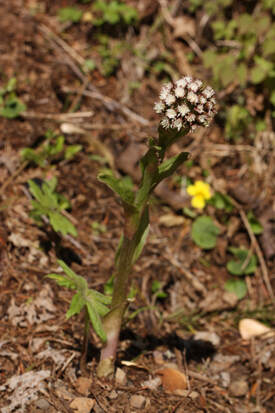 The species represented by this specimen, sweet coltsfoot (Petasites frigidus). ©2013 Walter Siegmund Title: Petasites frigidus 2144.JPG CC-BY-SA Eaton and Bailey reported over 60 species of tree, wildflower, and shrub in this Mountaineer article, frequently commenting on the stunning beauty of each. "[N]othing more frequently claims the attention of the Mountaineer and calls forth his expressions of delight than the flowers that carpet the hillside, or hide modestly under cliff or brush" (18-19). Apparently, they and other botanists also collected voucher specimens during their journeys, allowing us to scientifically verify their observations. Perhaps more poetically, they enable us to peek into the past, perhaps catching a glimpse in our mind's eye of the glorious sights these adventurers and scientists beheld. Herbarium specimens tell us real stories of the people, places, and plants of historical times and hopefully help us preserve them for the future. 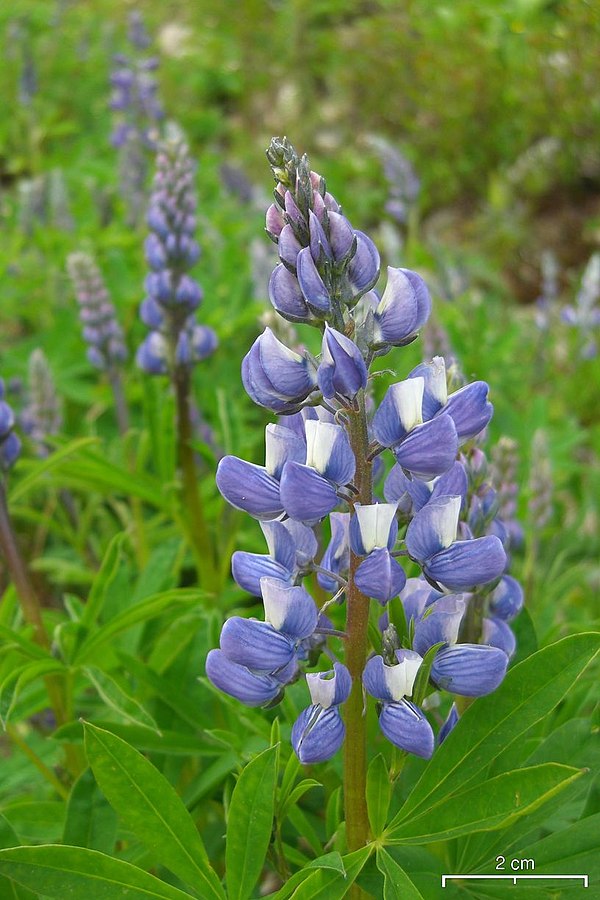 Lupinus latifolius var. subalpinus, one of the "blue" flower species dominating what the mountaineers dubbed "National hill", "because the effect was that of the colors of the flag" (p. 21). PC: Jason Hollinger CC-BY 2.0 Original Post References/Further Reading
|
Archives
August 2022
Categories
All
|
